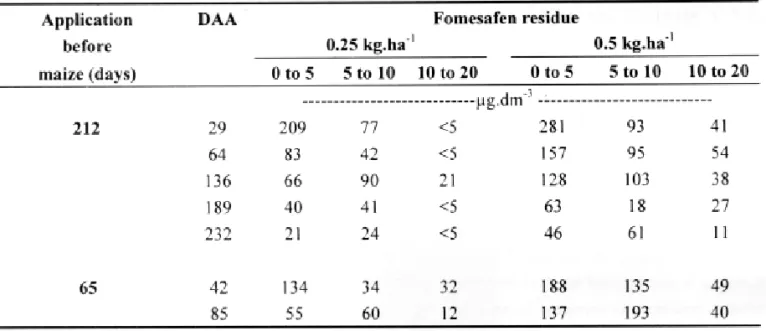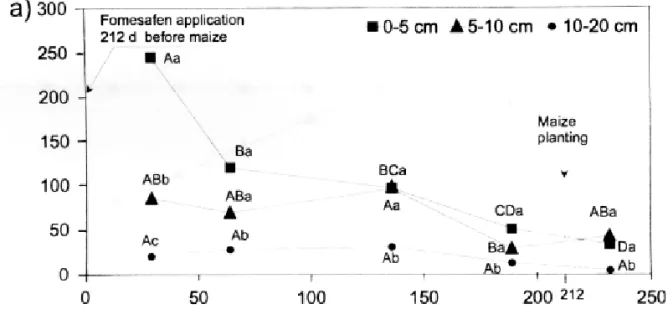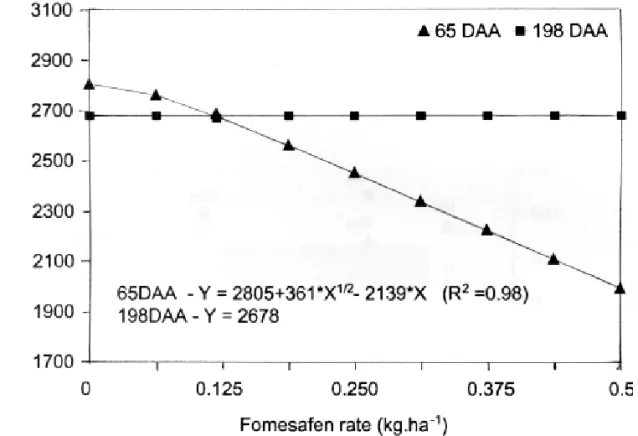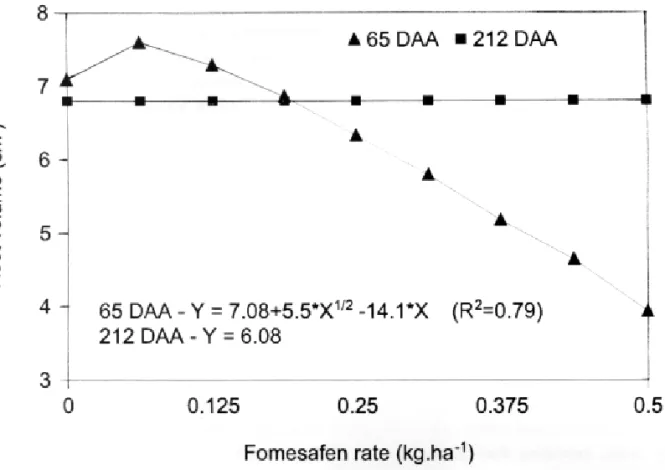TARCÍSIO COBUCCI2, .JOÃO B. SILVA3e HÉLIO T. PRATES3
RESUMO
Efeito de resíduo no solo de fomesafen, aplicado no feijão, no milho em sucessão Em do is ex pe ri ment os fo mesa fe n fo i
ap li ca do em pó s -emer gê nc ia em cu lt ur as do feijoeiro nas doses de 0; 0,125; 0,25; 0,375 e 0,5 kg/ha, em 1992 (abril e agosto) e em 1993 (março e agosto) em parcelas dist intas, para avaliar os ef ei tos de se us res ídu os no so lo ar gi los o (Latossolo Vermelho-Escuro) na cultura do milho. O milho foi plantado em sucessão 65 e 198 dias após aplicação de fomesafen em 1992 e 65 e 212 dia s em 199 3. Res ídu os de fomes afe n no sol o foram determinados por cromatografia liquida e foram det ect ado s até 20 cm de pro fun did ade , porém a maior concentração encontrada foi a 0-10 cm de profundidade. Nesta profundidade, a concentração de fomesafen variou de 21 a 24 e 55
a 60 ppb aos 212 e 65 dias após aplicação de 0,25 kg.ha-1 de fomesafen, respectivame nte, enquanto qu e a ap li ca çã o de 0, 5 kg .h a-1, ap re se nt ou concentrações de 46 a 61 e 137 a 193 ppb aos 212 e 65 dia s após aplicação , res pectiv amente. No plantio de milho aos 65 dias após aplicação de fo m es af en , re sí du os do he rb ic ida no so lo reduziram o teor de clorofila na folha e volume de raiz do milho aos 10 dias após emergência. A diminuição do teor de clorofila na folha e volume de raiz, entretanto, não afetaram o rendimento de grãos.
Palavras chave:difeni1-éter, persistência, sucessão,Phaseolus vulgaris, Zea mays.
ABSTRACT Ca rryo ve r ef fec ts of fom es af en on
successional maize were studied in clay soil. Fomesafen was applied as postemergence at five rate s (0; 0.12 5: 0.25 ; 0.37 5, and 0.5 kg/ha-1) to edible beans. Maize was planted 198 and 65 days after fomesafen application in 1992 and 212 and 65 days after fomesafen application in 1993. Fomesafen residues were detected in soils up to 20cm depth but residue concentration was higher in 0-10 cm soil depth. Fomesafen residues reduced
leaf chlrophyll content and root volume of 10 days old maize when planted 65 days after application but were not affected when planted 212 days after ap pl ic at io n. Ho we ve r, th e de cr ea se s in le af chl orophy ll and roo t volume did not aff ect the maize yield.
Ke y wo rd s: Diphen ylet her herbicide, herbicide persistence, crop rotation, Phaseolus vulgaris, Zea mays.
1Recebido para publicação em 18/04/97 e na forma revisada em 16/12/97.
2Pesquisador, Dr., Embrapa - Centro Nacional de Pesquisa de Arroz e Feijão (CNPAF), Caixa Postal 179, 74001-970 Goiania. GO. e-mail: cobucci@cnpaf.embrapa.br.
INTRODUCTION
The Brazilian Savanna, locally known as Cerrado, is the region where grain production has been improved, has distinct dry and wet seasons. The soils have excellent physical properties but are chemical ly poor . It is poss ible to grow two crops per yea r wit h irr iga tio n. Edi ble bea n is pl an te d fr om Ma rc h to Jul y, an d ma ize in Nove mber . The herbicide fome safen is used to cont rol broadleaf weed s in edible bean but the ef fe ct of so il fo me sa fen re si du e on ma ize following edible bean is unknown.
Fomesafen is a diph enylether herb icide and its degradation in anaerobic conditions occurs in les s tha n 3 we ek s, an d in ae rob ic so il conditions, herbicide half-life ranged from 6 to 12 months (Johnson & Talbert, 1993). Oymada & Kuwatsuka (1988), studying the conditions of d i p h e n y l e t h e r s ( c h l o r n i t r o f e n [ 2 , 4 , 6 -trichlorophenyl 4-nitrophenyl ether], nitrofen [2,4-di ch l or o ph e n yl 4-nitroph en yl et he r] an d chlonetoxynil [2,4-dichlorophenyl 3-methoxy-4-nitrophenyl ether]) degradation, reported that the ha lf- life pe riod s va rie d lar ge ly wi th so il conditions: 9 to 173 days for chlornitrofen, 3 to 87 d a y s f o r n i t r o f e n a n d 8 t o 6 4 d a y s f o r chlomethoxynil. The herbicides degrade rapidly in anaerobic conditions.
Weber (1993) reported that fomesafen exh ibi ted wea kly aci dic prop ert ies . pKA = 3,0 (ioni zed to ani oni c spe cie s as pH incre ased) . Mobility, bioavailability and degradability of the herbi cide fomes afen in soil is expec ted to be lower at low pH than at high or neutral pH, due to high sorption on soil coloids.
Johnson & Talbert (1993) determined carryover potential of fomesafen (0.28 kg.ha-1) to snap bea n (Ph ase ol us vul ga ri s) , wat ermel on (Citrullis lonatus),cucumber(Cucumis sativus),
mus t ar d (B r a s s i c a n i g r a ) and sunf l ower (He lia nth us ann uus ). The her bic ide inj ure d all cr op s in it iall y, bu t di d no t inju re sn ap be an , sunflower, watermelon and cucumber planted 16 weeks after application.
Santos (1991) applied fomesafen in edible bean and detected that the herbicide persisted until 100 days after application (DAA) of 0.25 kg.ha-1 and 180 DAA of 0.375 kg.ha-1, using sorghum as a test crop.
We is sl er & Po ol e (1 98 2) te st ed th e application of fomesafen (0.3 kg.ha-1) in columns, and leache d with 660 mm of wat er. More tha n 60% of the herbicide was located in the top 10 cm, 63 DAA. In soils with 6,0% and 2,1% of organic mat ter, her bicide conce ntrations, at the same depth, were 185 and 100 mg.dm-3, respectively.
The objective of the pres ent expe riment was to de t er mi ne the effec t of ca rr yo ve r fo mesa fe n re si du e on le af ch lo ro ph yl l, ro ot volume and grain yield on successional maize and to esti mate th e le vel of th es e re si du es un der Brazilian Cerrado soil conditions.
MATERIAL AND METHODS
Experiments were carried out in 1992 and 1993 (one in each year) in a dark red latosol of the National Maize and Sorghum Research Center of Embrapa, Sete Lagoas, Minas Gerais, Brazil, to evaluate the soil residue effects of fomesafen on maize. The herbicide was applied on a previous edible bean crop.
represented fomesafen rates, and the sub-plot the two periods of application.
The soil characteristics of each
experimental site are presented in Table 1. Precipitation and temperature data during the experimental period are presented in Table 2.
TAB LE 1.Tex tur al cla ss and some che mic al cha rac ter ist ics of the soi l. Set e Lag oas , MG, Bra zil ,
199 21993.
Edible bean was planted on March, 18 and July, 27, in each sub-plot, respectively, and the herbicide fomesafen was applied on April, 7 and Au gu st , 8 in 19 92 wi th a CO 2 - pr es su ri ze d backp ack sprayer del ivering 250 l.ha-1 at 275 kPa. In 1993, edible bean was planted on March, 2 and July, 16, in each sub-plot and herbicide was applied on March, 22 and August, 16.
Fomesafen residue: Chemical analysis of
soi l fomesa fen res idu e wer e per for med in the second year (1993), in the plots which received 0.25 and 0.5 kg.ha-1 of fomesafen. Soil samples composed of five subsamples taken at 0 to 5, 5 to 10 and 10 to 20 cm deep 29, 64, 136, 189 and 232 DAA in the plots where fomesafen was applied 212 days before maize and 42 and 85 DAA in the plots where it was applied 65 days before maize. Fomesafen residue was extracted by shaking 20 g of soil with 100 ml of acetonitrile: hydroc hloric acid (98:2), for 30 min in a horizontal shaker. The extract was filtered through a celite pad under va cu um. Re si du e wa s wa sh ed wi th 50 ml of acetonitrile. The extract (70 ml) - water (100 ml) mixture was transferred to a separatory funnel and shaken for 3 min with 100 ml of dichloromethane, an d th e lo we r ph as e (d ic hl or omet ha ne ) wa s collected. This procedure was repeated with an ad di ti on al 50 ml of d ic hl or om et ha ne . Th e co mb in ed di ch lor om et ha ne ex tra ct s we re ev ap or at ed to dr yn es s at 35 C on a ro ta ry eva por at or . T he r es idu e wa s take n up in chloroform (3 ml) and passed through a silica adsorption column chromatography. The elute was evaporated to dryness and taken up with 1 ml of acetonitrile: water (pH 2.5) 50:50. The amount of f o m e s a f e n w a s d e t e r m i n e d w i t h a h i g h pe rfo rma nc e li qu id ch ro ma tog ra ph y. The analytical conditions were: Shim-pach CLC-ODS (M), reverse-phase, with 4.6mm x 25cm in
stainless steel and 5 mm pore diameter, column t e m p e r a t u r e o f 4 0 ° C , m o b i l e p h a s e acetonitrile:water (pH 2.5) 50:50, flow rate of 2.0 ml. min-1, UV det ect or at 290 nm wav ele ngt h, sampl e amo unt of 20 ml. A lin ear cal ibrat ion curve was constructed using known fomesafen concentrations (0, 200, 600 and 1000 mg.dm-3). The solutions of known concentration consisted of analytical herbicide (chemical purity > 99%). The concentration of fomesafen in soil sample extracts was determined by entering peak area values into a regre ssion equation describing the calib ration curve. Fomesafen recovery from soil samples was 100%. The lower limit for detection of fomesafen in soil samples was 5 mg.dm-3
Effect of fomesafen residue on maize:
Ma iz e cu lt iv ar s, Ca rg il l 80 5, we re so wn on October, 22 in 1992 and BR 201 on October, 20 in 1993 in 90 cm rows, using 65.000 seeds ha.' and were mown 30 days after emergence. The seedling emerge nce, lea f chloro phyll con centra tion and roo t vo lum e we re me as ur ed 10 da ys af te r em er ge nc e. Ch lo ro ph yl l co nc en tr at io n wa s estimated by Arnon's method (Arnon, 1949). The sampl es were taken at the middle portion of the fir st lea f of 10 pla nts per plo t. The roo ts wer e wa sh ed an d pl un ge d in to gr ad ua te d tub es co nt ai ni ng 50 ml of wa te r to de te rm in e ro ot volume by water volume difference. Maize grain yield was estimated using the two center rows of each plot and adjusted to 13% of moisture.
RESULTS AND DISCUSSION
Fomesafen residue: Average data for
f ome sa of en rat e, so il dep t h an d DAA. A significant interacti on betwe en depth and DAA was observed. Based on these results, the study
was carried out usin g th e average fo mesafe n rate (0.25 and 0.5 kg.ha-1).
TABLE 3.Fomesafen residue (µ.g.dm-3) as affected by rate of application, depth (cm) and days after application (DAA) in two application dates before maize, Sete Lagoas, MG, Brazil, 1993.
When the herbicide was applied 212 and 65 days before maize, a significant decrease of its soil concentration 0 to 5 cm deep was observed as DAA increased (Figures la and 1 b). This was pr ob ab ly du e to mi cr ob ia l de co mp os it io n. Acc or di ng t o J oh ns on & Tal ber t (199 3) , fomesafen dissipation in the soil occurs mainly by microbial degradation. Oymada & Kuwats uka (1988) reported that diphenylether herbicides are degraded faster under reductive than oxidative c o n d i t i o n s , a n d t h a t t h e r e a r e m a n y micoorganisms in the soil which reduce the nitro group of such herbicides.
In Figures 1 a and lb, it can be obser ved that fomesafen residue concentrated more at 0 to 10 cm in th e so il pr of il e. We is sl er & Po ol e (1982) observed that 63 DAA (0.3 kg.ha-1 of fomesafen) in a loamy sandy soil (2.1% O.M.) and with 660 mm of precipitation, 60% of fomesafen
was located 0 to 10 cm deep. The authors concluded that fomesafen has a moderate mobil ity in the soil profile.
FIGUR E 1. Soil fomesa fen residue (means of 0.25 and 0.5 kg.ha-1rates ) as affected by DAA at three depths and two application dates. Means followed by the same letter are not significantly different according to Tukey's test at 0.05 level of probability. Capital letters were used to comp are mean s among DAA for any dept h and smal l letters to comp are mean s among depths for any DAA. Sete Lagoas, MG, Brazil, 1993.
Effect of fomesafen residue on maize: In 19 92, wh en th e in te rv al betwee n fo mesa fe n application an d maize pl anting was 65 da ys, th e le af ch lo ro ph yl l co nc en tr at io n an d ro ot volu me, meas ur ed 10 days af te r emer gence, decreased with increased fomesafen rates (Figures
FIGURE 2. Effect of fomesafen carryover residue from edible bean on rotational maize leaf chlorophyll concentration at 10 da ys after emer gence. Ma iz e planted at 65 and 198 da ys after fomesafen application. Sete Lagoas, MG, Brazil, 1992.
T h e d e c r e a s e o f l e a f c h l o r o p h y l l concentrations related to fomesafen residue in the soil can be explained by the protoporphyrinogen ox id as e in hi bi ti on (e nz ym e in ch lo ro ph yl l sy nt he si s pa th wa y) . Th en , no n-en zy ma ti c oxidation occurs, which forms protoporphyrin IX that interacts with oxygen and light, resulting in singlet oxygen forms. The non-enzymatic protoporphyrin IX is not an accepta ble substrate for Mg chelatase and contributes to the decrease in chlorophyll synthesis (Weller & Warren, 1992). The yellow stripes that appear on the leaves are the main symptom of fomesafen residue effect on maize. This may be due to decrease in chlorophyll concentration.
The ANOVA did not show significant effect for fomesafen rate and period of application for maize yield,. indicating that despite residue damage to maize plants observed 10 days after emergence, the crop is capable to recover with no negative effects on yield. One explanation for the symptoms observed in the initial stage of maize
development may be due to the fact that, at that time, roots were exploring the soil profile where fomesafen residue was more concentrated (0 to 10 cm), inducing the appearance of yellow stripes on the leaves. In later stages of plant growth, with deep er root proliferation, effects of fomesafen resid ue were overcome. It is import ant to notice that initial stand of maize was not affected by soil fomesafen residue. Seedlings death did not occur even with the highest rates of fomesafen (0.5 kg. ha-1) or wi th th e sm al le st in te rv al be tw ee n fomesa fen app lic ati on and mai ze pla nti ng (65 days). In 1993, within the same time range period ( 65 da ys ) , a s i gn i f i ca nt decr eas e i n l eaf chl oroph yll con centr ati on and root vol ume of maize was observed 10 days after emergence with incre asing fomes afe n rates (Fi gur es 4 and 5). These results are in accordance with those found in th e pr ev io us ye ar (1 99 2) , co nf ir mi ng th e neg ati ve eff ect of fom esa fen residue on ini tia l stages of maize growth. As in 1992, fomesafen residue did not affect maize yield significantly.
FIGURE 4. Effect of fomesafen carryover residue from edible bean on rotational maize leaf chlorophyll
FIGURE 5.Effect of fomesafen carryover residue from edible bean on rotational maize root volume at
10 days after emergence. Maize planted at 65 and 212 days after fomesafen application. Sete Lagoas, MG, Brazil, 1993.
T he re s ul t s obt ained i n t hi s st udy demonstrated that fomesafen application in edible bean crop, at the recommended rate of 0.25kg.ha-1, did not affect maize yield, even when the interval betwe en appli cation and maize planting was 65 days. Nevertheless, it is worth to point out that the persistence of herbicides in the soil may vary according to several factors, such as soil type, precipitation and temperature. On this basis, data presented here should be considered according to the test conditions.
ACKNOWLEDGMENTS
We th an k Ze ne ca Br az il fo r pa rt ia l financial support of this study.
LITERATURE CITED
AR NO N, D. I. Co op er en zy me s in is ol at ed chloroplasts. Plant Physiol., v.24, p.1-15,
1949.
HINGSTON, F.J., POSNER, A.M., QUIRK, J.P. Anion sorption by goethite and gibbsite. J.
Soil Sci.,v.23, p.177-192, 1972.
JOHNSON, D.H., TALBERT, R.E. Imazaquin, chlorimuron, and fomesafen may injure rot at ion al ve ge tab les an d su nf low er (Helianthus annuus). Weed Technol., v.7,
p.573-5T7, 1993.
NEWBY, S.E., WHITE, B.G. PP021: leaching on
soil thick-layer chromatograms. Lond on, ICI, 1981. 4p. (Report RJ0156B).
herbicides in flooded soils .J. Pest ic. Sci. , v.13, p.99-105, 1988.
SANTOS, J.G.M.Controle químico de plantas daninhas na cultura do feijão(Phaseolus
vulgaris L.),no inverno.Viçosa, UFV,
1991. Tese de Mestrado.
TISDALE, S.L., WERNER, S.L., BEATON, J.D. Basic soil-plant relationships. In: T I S D A L E , S . L . , W E R N E R , S . L . , B E A T O N , J . D . S o i l f e r t i l i t y a n d
fe rt il iz er s. 4. ed . Ne w York ,
Ma cmil la n Publishing Co., 1985. p.95-111. WE BE R, J.B . Io ni za tion an d so rpt ion of
fomesafen and atrazine by soils and soil consti tuents. Pe st ic . Se i. , v. 39 , p. 31-38 , 1993.
WE IS SL ER , M. S. , PO OL E, N. J.
Mo bi li ty of fo me sa fe n an d
de gr ad at io n pr od uc ts in so il
co lu mn s. Lo nd on , IC I, 19 82 . 3p .
(Report RJ0241 B).
WELLER, S.C., WARREN, G.F. Diphenylethers and oxad i azo n. In : WELLER, S.C., WARR EN, G.F. Her bic ide act ion cour se.





